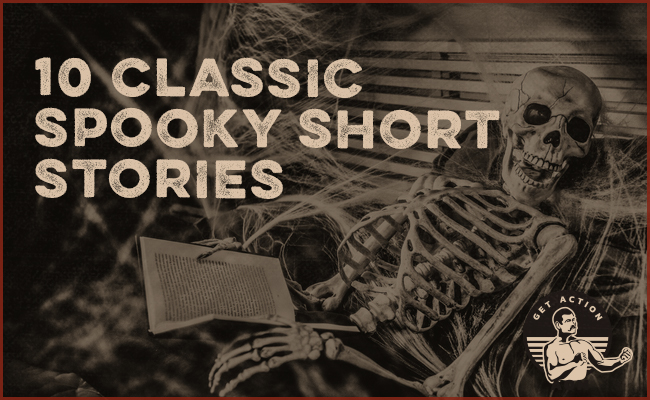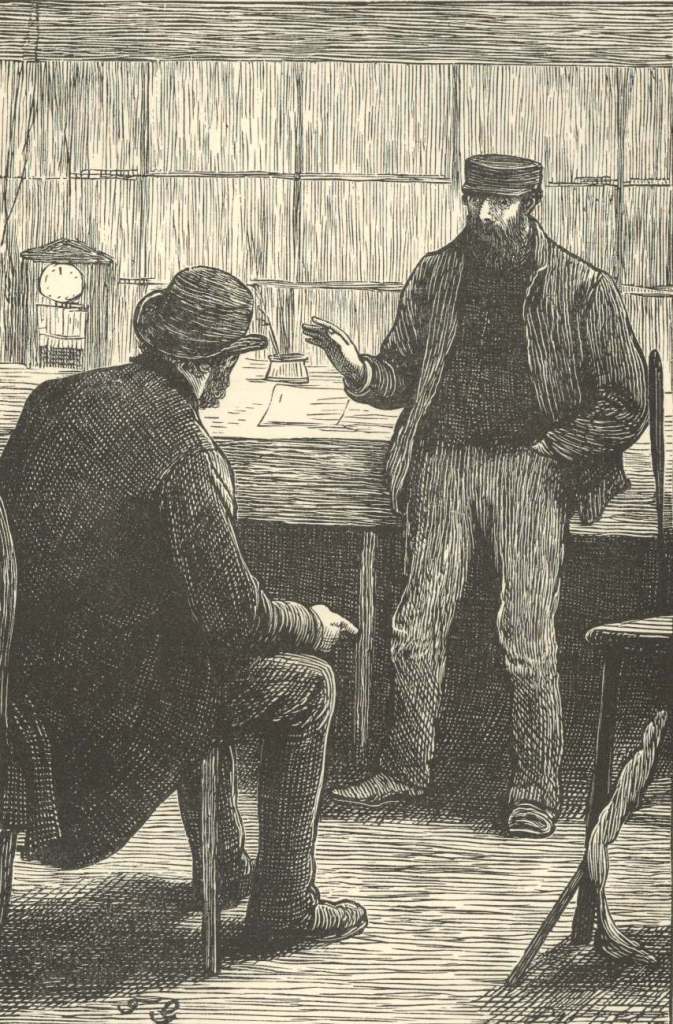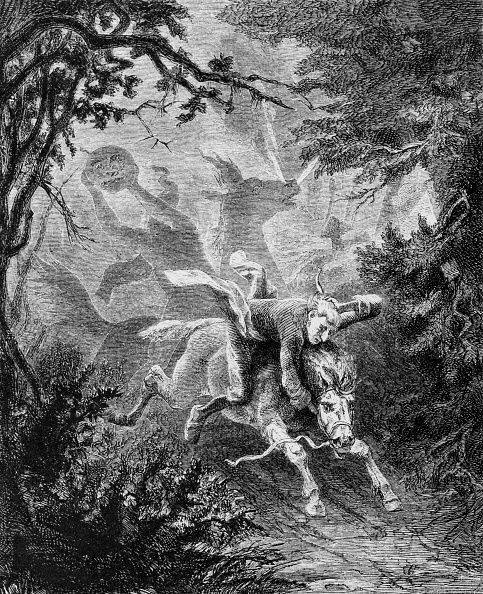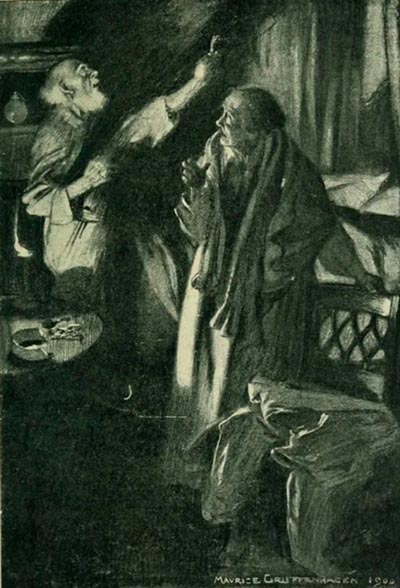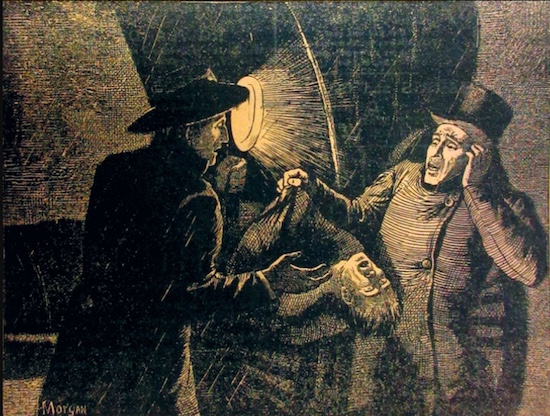To get into a spooky state of mind this time of year, many will turn to watching horror movies — slasher films filled with plenty of blood, guts, and chainsaws.
While the visceral frights of these terror-inducing flicks can certainly be fun, by my lights, the best way to tap into a seasonal mood of dread and apprehension is not via cinema but the printed page — particularly the short story.
Short stories can be read in less time than it takes to watch a movie (or read a book), and offer a potent dose of fright, providing chills that are also frequently more nuanced and layered.
This is true not only in the way they subtly build suspense by hinting at what lurks off center stage and around a corner, rather than describing it directly, but in the way they often use a horror-filled tale to explore deeper moral and philosophical issues.
When writing in the genre of the macabre (meaning, in art, that there’s a grim and deathly quality to it), many authors — especially those of the late 19th and early 20th centuries — took advantage of the chance to touch on the nature of fear: how it grips our conscience; how heroes, cowards, and villains deal with it; and how the scariest things in life aren’t monsters and mummies, but the darkest shadows of our own hearts.
It’s for this reason that in reading dozens and dozens of scary short stories, old and new-ish alike, I quickly realized I was far more drawn to the former. Below you’ll find 10 of my favorite classic tales of the macabre. All can be read free online, usually in the span of 10 minutes or so, with the longest only taking a half hour. Despite the minimal time commitment, there’s a good chance they’ll enduringly haunt your imagination.
“Chickamauga†by Ambrose Bierce
I read a couple dozen of Bierce’s stories and the most impactful, without a doubt, were those contained in his Civil War Stories collection. While the supernatural elements found in his non-war stories can certainly elicit fear, the realistic nature of the fictional Civil War stories only adds to their horror. Combine that with the twist endings that Bierce is known for, and you end up with some truly jaw-dropping tales.
His entire collection of Civil War tales is worth reading. Bierce’s frontier-like voice is unique in short stories, especially within this horror/supernatural genre. Where as many of these others are pretty Victorian, Bierce wrote with a uniquely American pen.
While “An Occurrence at Owl Creek Bridge†is his most famous of these stories (and is considered by many scholars to be one of the greatest in American literature), it’s “Chickamauga†that has stuck with me the most. In telling the story of a lost young boy who happens to wander across a battalion of injured soldiers, Bierce manages to turn the idea that “war is hell†from vague platitude into visceral twist in the guts.
“The Signal-Man†by Charles Dickens
Charles Dickens was no stranger to writing ghost stories. It’s easy to forget, in fact, that A Christmas Carol is rife with ghosts, and it’s actually a slightly scarier story than the innocent adaptations you usually see come the holidays. We’re just so familiar with the tale that it’s hard to read it with fresh eyes.
Dickens’ ghosts aren’t usually objects of pure fright; in almost every supernatural tale of his they function more as a visible specter of one’s intuition, a warning and guide that something important is happening (or about to happen).
Among the handful of this type that Dickens penned, my favorite for the Halloween season is “The Signal-Man.†It involves a rural rail line, a creepy tunnel, and an apparition that forewarns of terrible accidents.
It’s admittedly not a particularly scary story — it’s more about intuition than the macabre — but it’s classic Dickens, and provides a bit of a shock ending.
“The Legend of Sleepy Hollow†by Washington Irving
The tale of the headless horseman has perhaps inspired more pop culture re-creations than any of these other stories. The small rural hamlet; the dark, foggy forest that resides nearby; the whinnying cry of the massive black horse; the midnight-clad rider with a headless profile. The mental image is an easy one to conjure, especially on a cold fall night.
The actual story behind that image is perhaps different than you remember, though. As a slightly longer tale, about 30 minutes to read, there’s more of a plot than many of the others on this list. (Which is likely why it’s engendered so many cultural takes.)
Ichabod Crane is competing for the hand of the daughter of a wealthy farmer. After a harvest party one fall evening, he heads home through the forest and encounters the horseman he’d heard of for so long. What happens next, though, may just surprise you.
“The Lottery†by Shirley Jackson
There’s nothing supernatural in Jackson’s most famous tale; just the sociological terror of what can happen when tradition is blindly followed and mob mentality takes over.
Not many details are given in regards to time or place; it’s a small town that’s observing an annual event — the “lottery.†All the townspeople are gathered; children have snuck in at the last minute, spouses are bickering, wives are chatting about wanting to get back home to do the chores. Meanwhile, an emcee of sorts is pulling names out of a box. The entire story builds and builds without ever really cluing us in to the lottery’s “prize†until the very end.
“The Lottery,†as with all of Jackson’s stories, takes the form of an almost domestic and subtle terror — there’s a breezy quality to it. The characters themselves aren’t scared of what’s happening; they’re sort of just resigned to it. And so that becomes how you as the reader feel as well, which leaves you with a twisted feeling about what just happened.
The story sparked outrage upon its initial publication in The New Yorker, much to the surprise of Jackson and her editors, but has come to be regarded as one of the finest short stories in all of American letters. For good reason.
“The Tell-Tale Heart†by Edgar Allan Poe
An early pioneer of the horror genre, authors like Arthur Conan Doyle, HG Wells, Fyodor Dostoevsky, Stephen King, and many more, all count Poe as a direct influence. The quality and value of Poe’s work has long split literary critics, and though he has his deriders (most prominently, the late Harold Bloom, RIP), there are plenty who label the 19th century master as the single most influential American writer, in any genre.
As such, the canon of Poe’s work remains embedded in America’s literary and cinematic consciousness. From “The Raven†(and my personal favorite take on it in The Simpsons), to “The Black Cat,†and dozens of others, you’ll find references to his work everywhere you look within the genre.
His greatest work, in my humble opinion, is “The Tell-Tale Heart.†As with all his stories, there’s a manic energy to it which frightens from the get-go; you truly never know what the characters are going to do, because they’re all somewhat crazed (a little like Poe himself). In this particular tale, an unnamed and very unreliable narrator is suffering from some sort of general nervousness; his senses are acutely tuned to what’s going on around him. This narrator ultimately decides to kill his roommate, which he does, and then fully believes he’s gotten away with it. But that isn’t the end of the story. Even though you undoubtedly know the outline, the tale is absolutely worth the handful of minutes it will take you to read. (It’s also great fun to listen to.)
“The Monkey’s Paw†by W. W. Jacobs
Here’s another story that’s made its way into pop culture in numerous forms, and is quite possibly my favorite in this list. I always appreciate when macabre stories not only bring an element of fear, but at the same time teach you something valuable about the essence and nature of that fear.
In this short tale, Jacobs introduces us to Mr. and Mrs. White, who acquire a cursed monkey’s paw from a friend. This paw supposedly grants three wishes to its owner — a claim that’s jokingly rebuffed by the Whites and their son. And yet, Mr. White can’t resist the allure of at least trying the thing out, and flippantly wishes for 200 pounds (tis a British story).
As the reader can guess, they get their wish, but it brings some unintended and horrific consequences. Further wishes only exacerbate the problem, and the Whites come to understand that rather than always grasping for more, it’s better to say, as Mr. White does before making his first ill-fated request, “It seems to me I’ve got all I want.”
“The Outsider†by H. P. Lovecraft
Lovecraft was a master of “weird fictionâ€; he’s even credited with establishing the sub-genre of that name. What does this mean to the average reader? He wrote within horror, but featured strange, alien-like creatures and blurry mythologies (versus well-crafted and tightly-conceived backstories). Most of his stories just weren’t really in my wheelhouse. Those most famed include “The Call of Cthulhu,†“The Whisperer in Darkness,†and “The Shadow Over Innsmouth,†among others.
There was one story that I quite enjoyed, however, which was “The Outsider.†A shadowy, unnamed individual has been residing in a castle for his entire waking memory of life. Eventually this person decides to break free of confinement and sets about navigating the castle’s dark corridors and sky-reaching towers in order to find the freedom he so craves.
When he finds his escape he wanders to another castle in the countryside and encounters a lively party; the guests are in for as much a surprise as our mysterious narrator himself.
“August Heat†by W. F. Harvey
This wasn’t a tale or author I’d ever heard of before digging into some classic story collections, but holy moly did it leave an indelible impression on me.
On a hot August day, artist James Clarence Withencroft has made a random sketch from his imagination of a criminal who’s just been sentenced and is waiting on a dock to be taken away. Later in the evening, James goes for a walk and wanders into a stonemason’s shop. To his utter surprise, the man who is now engaged in carving a headstone, is a direct match for the criminal who James pictured earlier.
The artist mentions this to the stonemason, prompting the reader to think, “Don’t do that you idiot!†But nothing unseemly happens and the two men have a chuckle about it, innocently assuming they’ve seen each other before about town.
And yet, that’s not the end of the tale. On this particular August day “the heat is stifling.†So hot, in fact, that it could “send a man mad.†One of the better endings you’ll come across on this list.
“The Empty House†by Algernon Blackwood
Blackwood was one of the most prolific story writers of the early 20th century, and like Lovecraft, often wrote in that “weird fiction†subgenre that was heavy on the supernatural and paranormal. His most well-known works, “The Willows†and “The Wendigo,†are a little long to be included in this list; they’re more novella than short story.
Blackwood wrote one brief tale, however, that made me shiver on the warm fall day I read it. “The Empty House†is your classic haunted house story. An elderly aunt and her nephew decide, for reasons that are not entirely clear, to spend a night in an old ramshackle place that’s rumored to be haunted.
The pair venture inside and are almost immediately inundated with strange noises, breezes, door closings, phantom footsteps, and more. As a reader, you’re wondering the whole time: Are these “ghosts†real? Part of their imagination? Will the specters do them harm or are they more of the Casper variety? Yet, as with any good haunted house story, the suspense is less with the ghosts themselves than with the psychological terror which permeates the walls of a dark, creepy home.
You won’t be venturing to the kitchen for that midnight snack so easily after reading this tale.
“The Body-Snatcher†by Robert Louis Stevenson
While Stevenson is better known for his adventure novel Treasure Island, and the novella-length Strange Case of Dr. Jekyll and Mr. Hyde, he did also contribute a few short stories, one of which has endured and is often found in fright-filled anthologies.
Like many of these classic stories, “The Body-Snatcher†is as much a philosophical and moral prodding as it is a mere effort in terror. While there are certainly some scary elements (especially near the end), the gist is that the conscience is not easily shaken off by ambition, greed, or anything else.
The characters and plot line found in this story mirror the real-life body-snatching phenomenon of the early and mid-1800s, in which freshly interred bodies were often stolen from graveyards for the purpose of being sold to medical schools as dissection samples. In Stevenson’s fictional tale, two older doctors run into each other and come to remember their time as students under a notorious professor. Part of their duties included taking receipt of bodies, but eventually things took an even darker turn when corpses started showing up under rather suspicious circumstances.
For more literary recommendations, keep up with all my reading by subscribing to my weekly bookish newsletter.
Tags: Books

